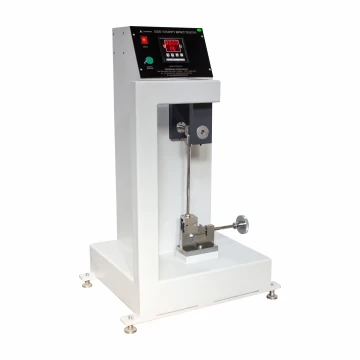In the world of packaging and material science, the ability of materials to endure sudden shocks or impacts during transportation, handling, and usage is a critical factor. The Charpy Impact Test serves as a fundamental method for assessing the toughness and impact resistance of these materials. This standardized test plays a pivotal role in the paper and packaging industry, allowing for the evaluation of a material’s capacity to absorb energy before breaking, ensuring the quality and durability of packaging materials.
At the heart of the Charpy Impact Test lies the Charpy Impact Tester, an indispensable piece of equipment used to carry out this assessment. Comprising various components, this apparatus operates by utilizing a pendulum that is raised to a specific height and then released to strike a notched specimen of the material under examination.
Charpy and Izod impact tests determine how tough materials are by measuring the energy they can absorb. This helps to understand how likely something is to break. For instance, glass absorbs less energy compared to metals like copper or aluminum. The Charpy Impact Tester is a precise machine used in industries such as rubber, forging, and plastics to study how materials handle impacts. It's important because it helps to know how much a material can change shape when hit. This test measures how much energy a material can handle before it changes. It uses a swinging pendulum to hit a notched sample to measure its strength.
The impact of the pendulum breaks the specimen, and the energy absorbed during the fracture is measured and quantified. This measurement involves analyzing the difference between the potential and kinetic energy of the pendulum before and after impact, providing a quantifiable measure of the energy absorbed by the material.
Vital components of the Charpy Impact Tester
Key components of the testing equipment include the pendulum itself, responsible for striking the specimen, the specimen support that securely holds the material in place for the impact, a notching tool used to create a controlled break in the specimen, and a measuring scale or digital display that indicates the amount of energy absorbed by the specimen upon impact.
The results obtained from this paper and packaging testing equipment are pivotal for manufacturers. They offer insights into the brittleness or toughness of their materials, specifically in the realm of paper and packaging. This information is essential in guaranteeing that materials can withstand the various stresses encountered during handling, shipping, and utilization without failure or breakage. Ultimately, it aids in the design and development of packaging materials that provide adequate protection for the products they encompass.
Helping Manufacturers Make Wise Decisions
By comprehending a material’s impact resistance through the Charpy test, manufacturers can make informed decisions regarding material selection, design, and overall product quality. This, in turn, contributes significantly to the enhancement of packaging materials, ensuring their reliability and safety for a myriad of applications.
The Charpy Impact Test serves as one of the best paper and packaging testing equipment that evaluates the material’s ability to resist impact and absorb energy, offering invaluable insights into its strength and durability. This testing method holds immense significance, particularly in the context of the paper and packaging industry, where ensuring the integrity of materials is paramount for delivering products securely and maintaining their quality throughout the supply chain.
In essence, the Charpy Impact Test is not merely a mechanical evaluation but a cornerstone in the development and assessment of packaging materials. Its role is pivotal in enabling the production of packaging that safeguards the contents within, guaranteeing their safe arrival at their destinations while upholding the quality and integrity of the products.
The implications of these experimenters go far beyond mere scientific research; They directly impact the customer experience by ensuring that packaging is reliable, robust, and resilient to disruptions in handling, shipping and handling This stand as evidence demonstrating the industry’s commitment to safe delivery and maintaining quality, all while minimizing the risk of damage or breakage.
In conclusion, the Charpy Impact Test plays an instrumental role in the continual evolution of packaging materials. Its ability to assess and quantify a material's resistance to impact helps in crafting packaging solutions that endure and protect, thereby advancing not only the safety and reliability of products but also the efficiency of the supply chain as a whole. This test serves as a testament to the industry's commitment to innovation and quality, ensuring that materials withstand the challenges they encounter in their journey from production to the end-user.


